Prime Minister Stephen Harper is expected to visit Canada’s governor general this weekend to ask him to dissolve parliament–launching the longest federal election in the country’s history.
Mr. Harper will be seeking to maintain his Conservative Party’s majority in the House of Commons in the expected Oct. 19 vote.
It will not be easy.
A drop in world oil prices has a resulted in Canada’s economy bordering on recession and a plunge in the Canadian dollar, leaving the Conservatives running neck-and-neck or trailing the left-of-centre New Democratic Party in most opinion polls.
Also weighing against Mr. Harper is anger over scandals involving senators he appointed to Canada’s upper house. and the fatigue factor.
And he must face the voter-fatigue factor. He has been prime minister since 2006. Too much familiarity can breed a lot of contempt in politics.
On the plus side, pundits say that the long campaign will benefit the Tories, who have more money to spend than either the NDP or the Liberals.
Mr. Harper’s best hope is a split in the opposition vote.
In 2011, he won his majority with just under 40 per cent of the vote. That was good enough to trump the just over combined 50 per cent support won by NDP and Liberals (31 per cent for the NDP, 19 per cent for the Liberals).
The NDP and Liberals have been sending out feelers to each other, but so far there is no indication they will unite.
The Conservatives currently hold 159 seats in the 308-member House of Commons. They are followed by the NDP (95 seats), the Liberals (36 seats). Fourteen seats are held by minor parties and independents. Four are vacant.
Thirty new seats have been added in this year’s election.







For reasons beyond our control, and for an undetermined period of time, our comment section is now closed. However, our social networks remain open to your contributions.